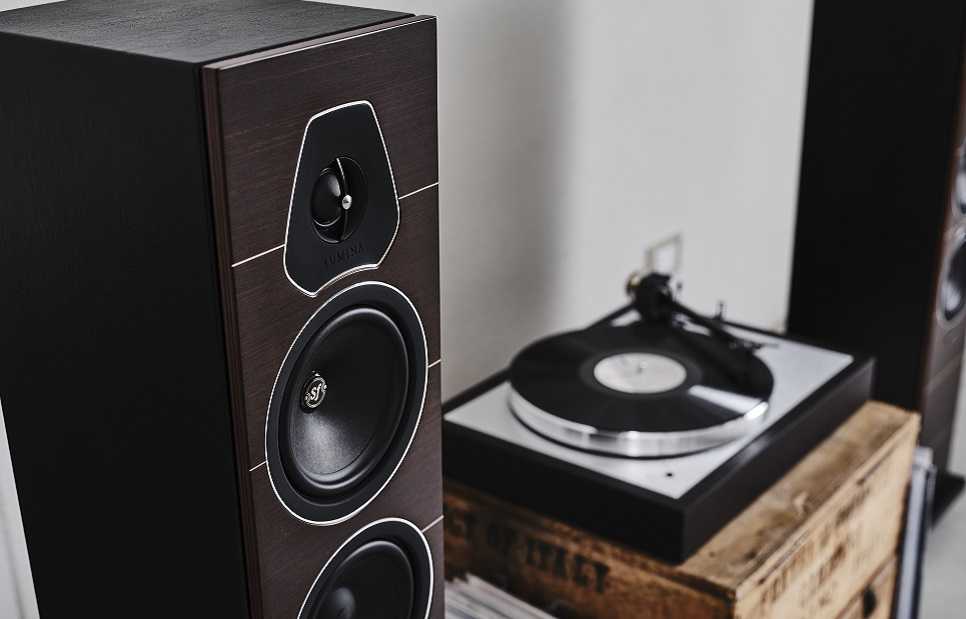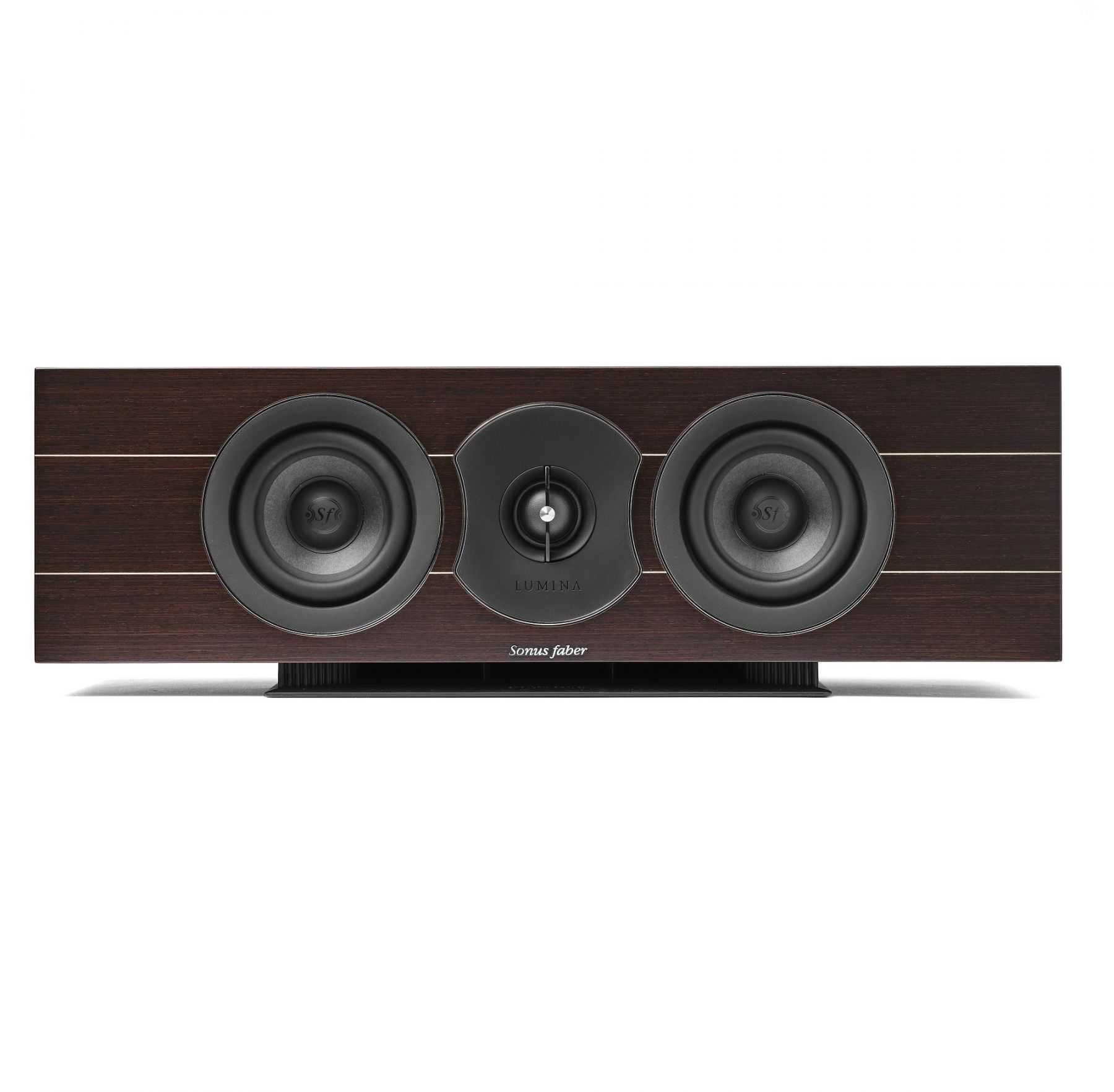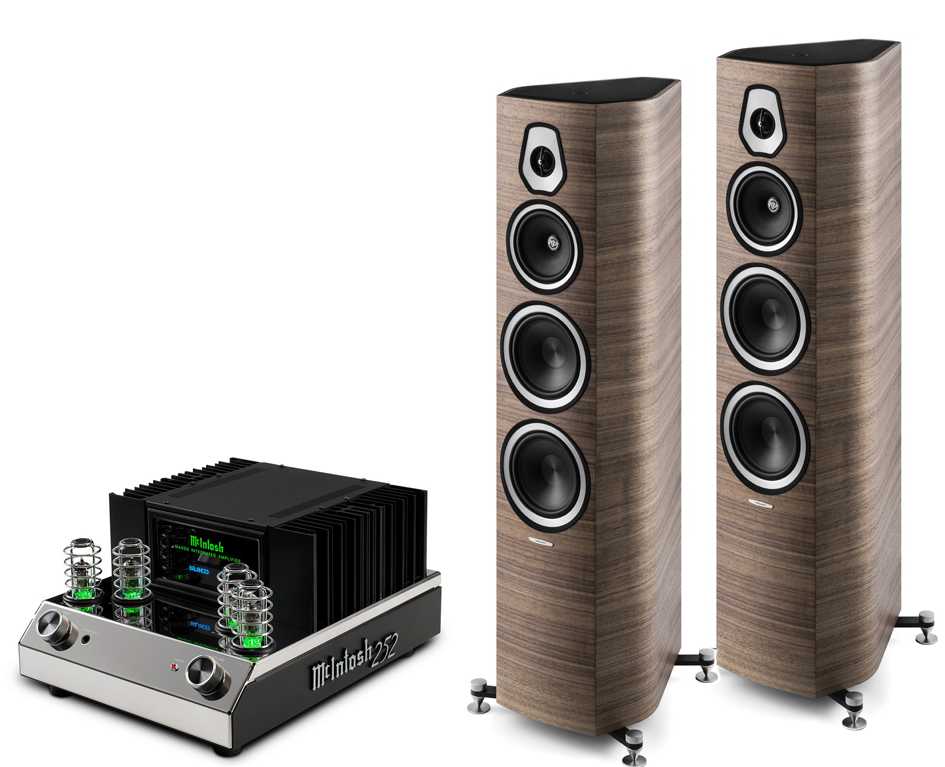Compatibility
(Image credit: Sonus Faber)
In electrical terms, these are relatively demanding speakers. The combination of low sensitivity – 84dB/W/m – and a nominal impedance of 4 ohms means that they’ll take a bit of driving. If you’re planning on going the hi-fi separates route, something the standard of the Rega Elex-R amplifier is a good pace to start, partnered with a similarly capable source, such as the Cyrus CDi CD player or Cambridge Audio Azur 851N streamer. Naim’s Uniti Atom one-box system also makes for a good match.
In the manual, Sonus Faber suggests placing these speakers at least a metre away from the wall behind them. However, in our test room they sound most balanced a lot closer – around 20cm away. Any further out and they start to sound insubstantial at low frequencies and a little thin overall.
It just goes to show that positioning advice should always be used as the starting point rather than the destination. We agree with the manual that the speakers should be angled directly at the listening position; they sound more direct and detailed when used in this way.
С разным аккомпанементом
Для оценки акустики был подготовлен полностью аналоговый тракт с проигрывателем винила Thorens TD 1601, оснащенным головкой Sumiko Starling. В паре с ним работал фонокорректор YBA Genesis PH1.
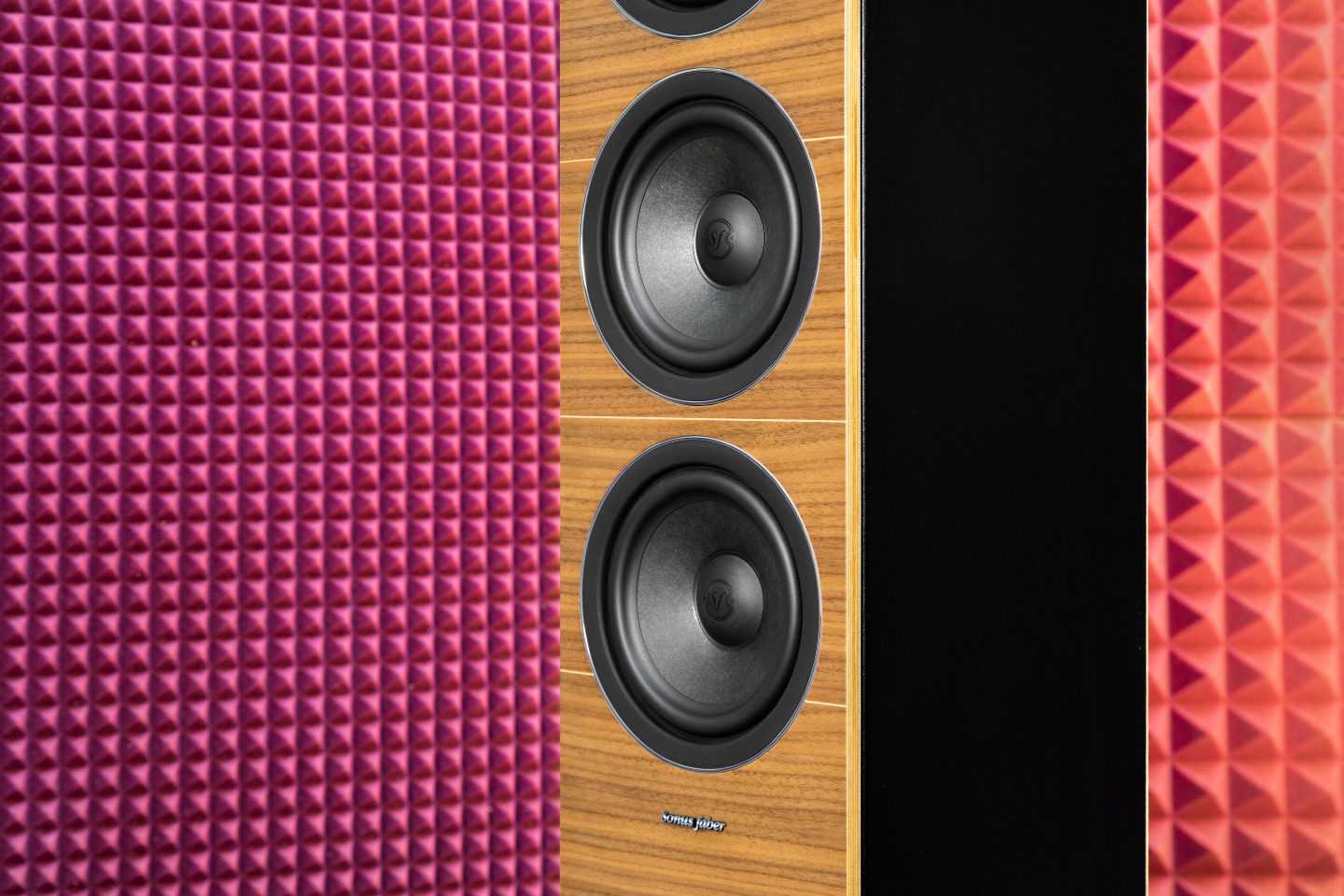
Антураж помещения так и располагал к прослушиванию классики, и потому сначала я опустил тонарм на пластинку с Bolero Жозефа Мориса Равеля в исполнении швейцарского Orchestre de la Suisse Romande под управлением его первого руководителя Эрнеста Ансерме.
И первое впечатление, характерное для акустики высокого класса — это когда забываешь, что тебе сейчас положено рефлексировать над особенностями подачи колонок, и начинаешь просто слушать музыку.
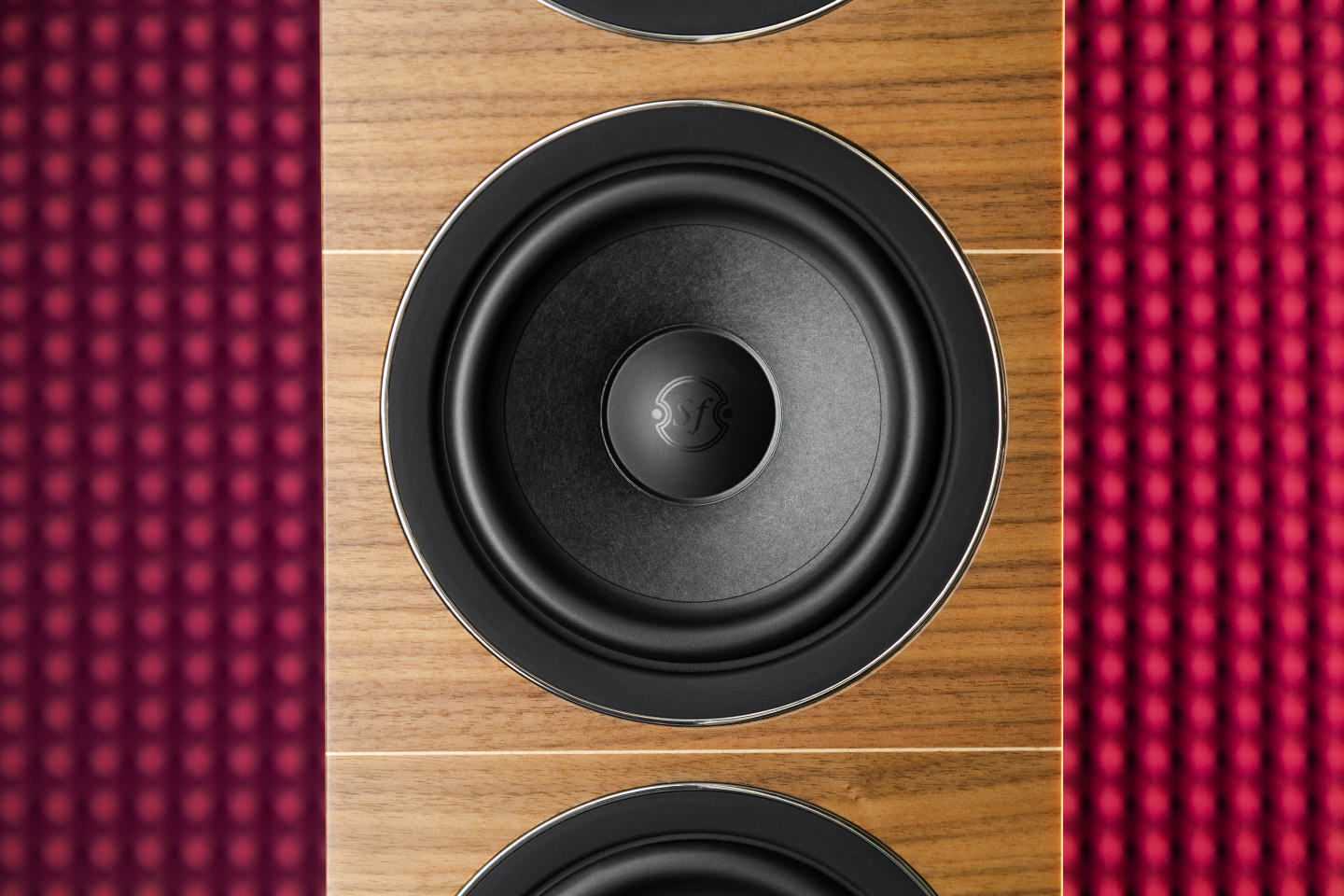 Для дебютной серии были разработаны новые 150-мм низкочастотные динамики
Для дебютной серии были разработаны новые 150-мм низкочастотные динамики
А она подается естественно, свободно, с аккуратными натуральными низами и без какой-либо искусственной красивости и нарочитости. То же можно сказать и про винил с версией «Севильского цирюльника» Джоакомо Россини на немецком языке от Deutsche Oper Berlin. Аппаратура выдает звучание чистое и живое — с хорошим запасом по динамическому диапазону и широкой информативной сценой.
Меняю усилитель на современную версию легендарной ламповой модели McIntosh MC275. Звучание стало собраннее, чуть резче, в нем появились нюансы, которые выражаются, скорее, не в материальных герцах, а в собственных ассоциациях — у меня создалось такое ощущение, словно к вибрации струн у скрипки добавились призвуки от корпуса и деки.
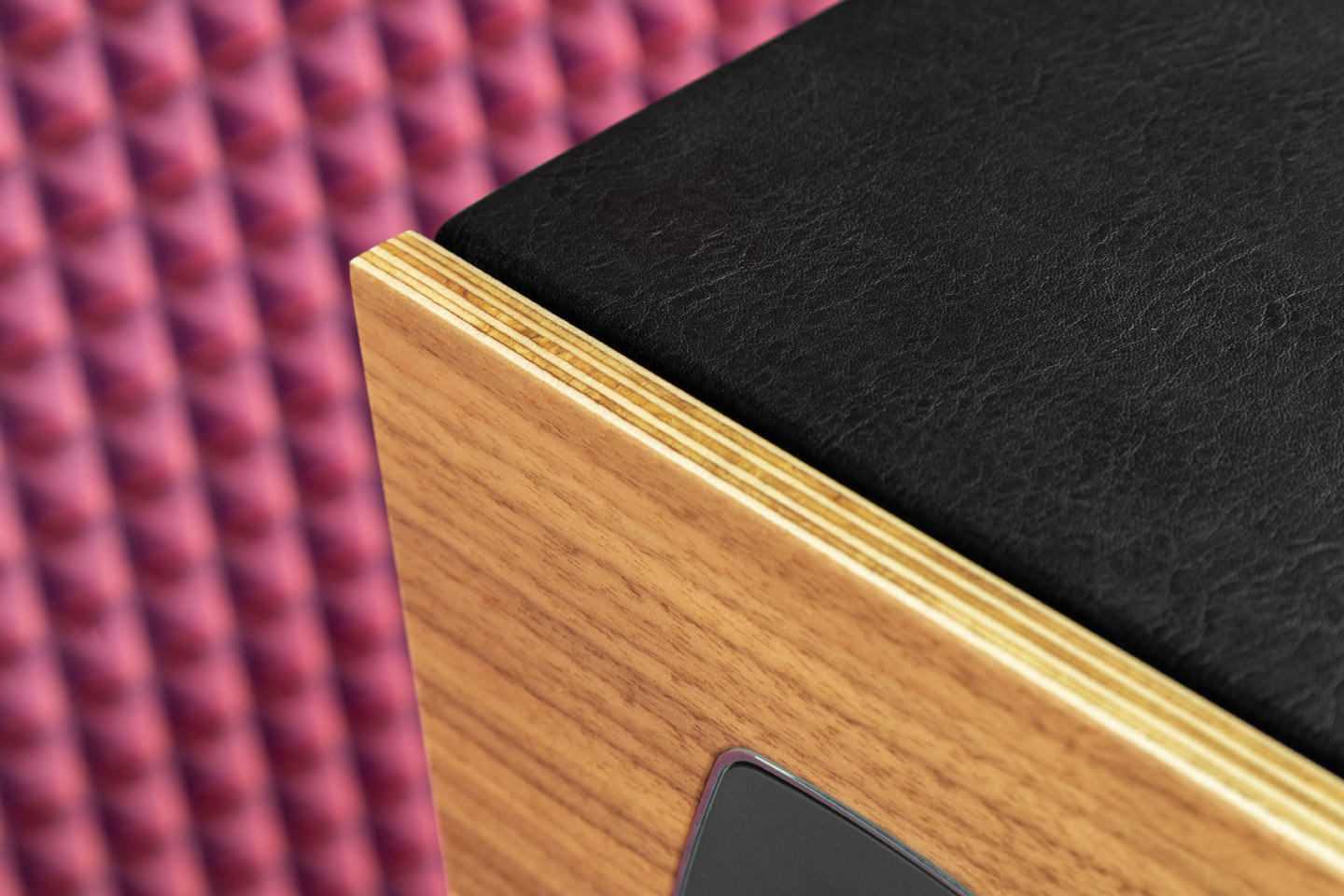 Фанера и кожа – сочетание необычное, но у итальянцев получилось это стильно обыграть
Фанера и кожа – сочетание необычное, но у итальянцев получилось это стильно обыграть
Надо прослушать тот же материал на полочниках Lumina I, подключенных к YBA Genesis IA3. В недоумении верчу головой — а мы точно не забыли переключить разъемы от старшей модели? Слишком уж мощно, насыщенно и эффектно для своих размеров и паспортных характеристик зазвучали двухполосники. По сбалансированности их подача в целом схожа с напольниками, но она более легкая, прозрачная и яркая.
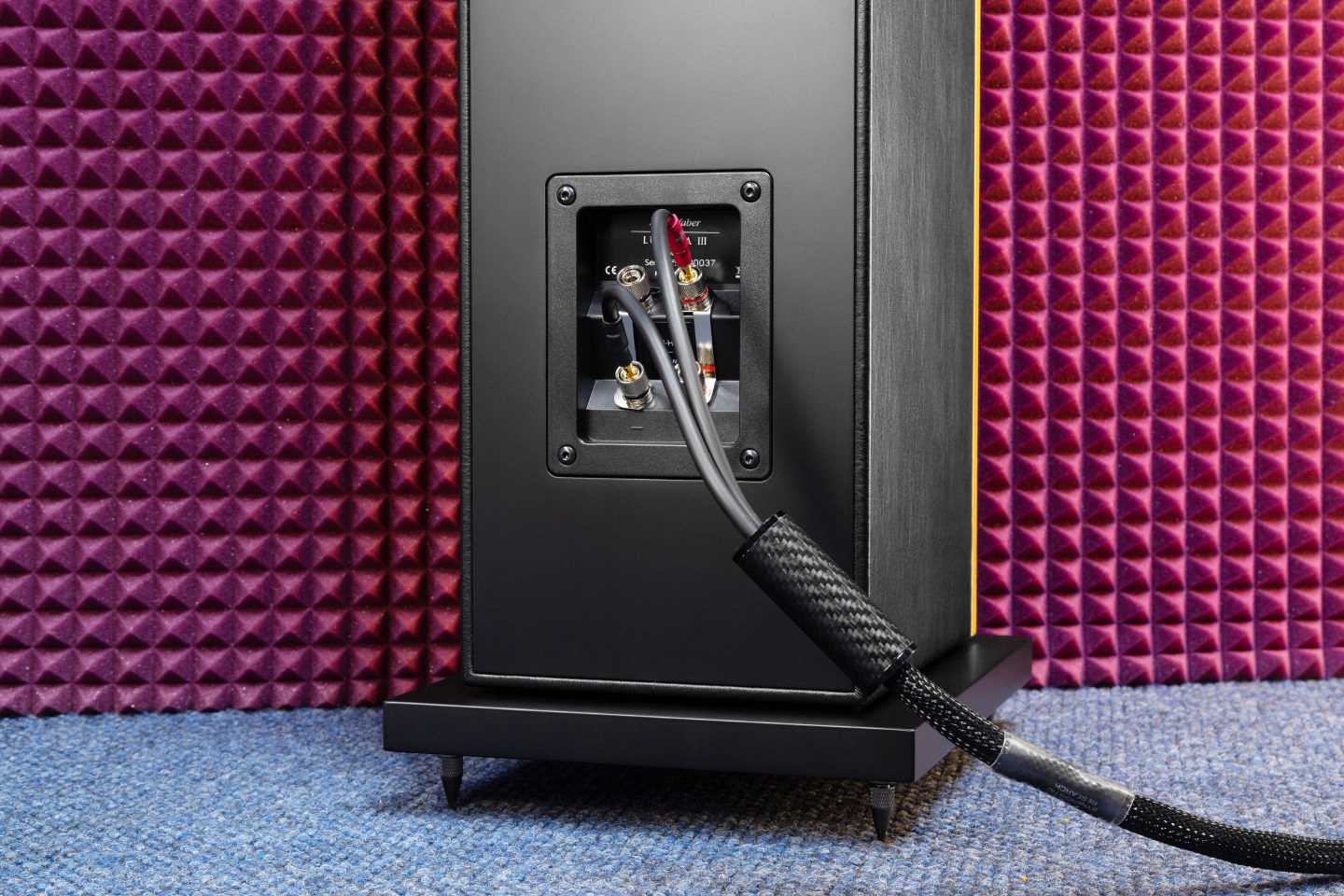 Вся линейка Lumina оснащена никелированными разъемами bi-amping/bi-wiring
Вся линейка Lumina оснащена никелированными разъемами bi-amping/bi-wiring
Если напольники выразительно наполняли помещение звуками, создавая подчеркнуто широкую сцену, то полочники будто бы полностью растворились в пространстве — с закрытыми глазами мне бы не удалось уловить их локализацию и найти границы комнаты. Передо мной рисовался наглядно выстроенный образ оркестра, а не условная пара акустических систем.
Пожалуй, поклонники классической музыки захотели бы купить Lumina I только за это, если бы напольники явно не лидировали в прорисовке нижнечастотного диапазона — например, виолончели у них гораздо телеснее и объемнее.
Sound quality
- Smooth integration of the frequency range
- Direct-yet-civilised presentation
- Not the most rhythmically adept speakers around
In some ways, the Lumina 1 are as accomplished as any price-comparable alternative. Of course, this means that in some ways they’re not, but that hardly seems the most charitable place to start.
Listening to Terry Callier’s You Goin’ Miss Your Candyman gives a pretty full account of the Sonus Faber. They’re a quite startlingly upfront, assertive listen; there’s no equivocation to the Lumina 1 sound, but rather a direct and unambiguous delivery of the music.
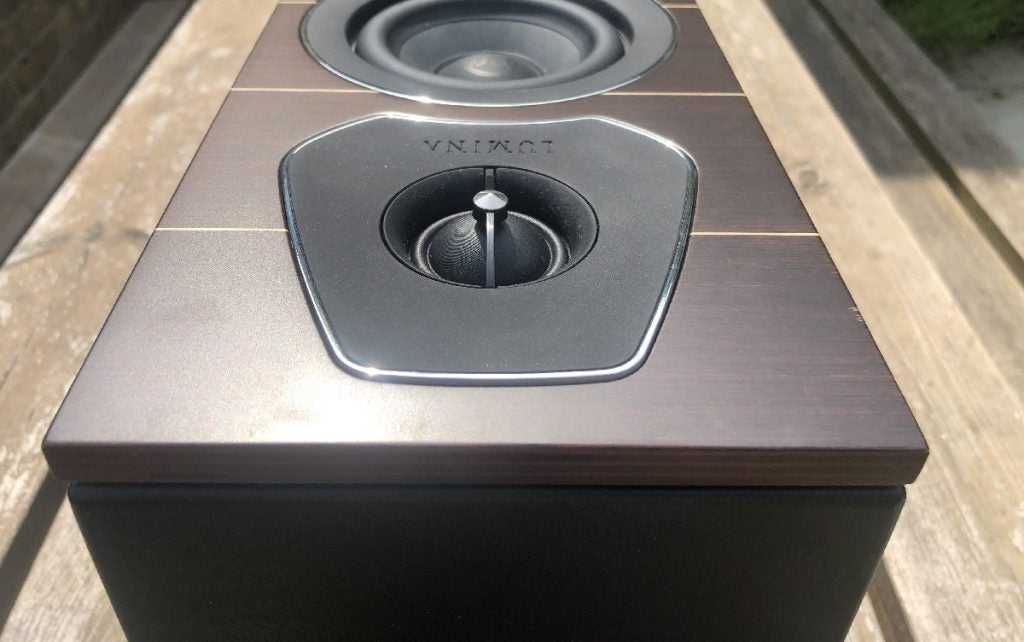
Low frequencies inevitably lack a little extension, but the bass these boxes produce is full bodied, taut and enjoyably detailed. At the opposite end of the frequency range there’s a nice combination of bite and finesse, so treble sounds are convincing as a result. And in between, the Lumina 1 do genuinely impressive work with vocals: they reveal a stack of detail concerning tone and timbre, and consequently a singer as individual and distinctive as Callier sounds fully characterful. Integration between the two drivers is impressive, and there’s real unity to the way the Sonus Faber present the overall recording.
As you might have guessed, given the physical constraints these speakers work under, they’re not the most expansive or dynamic listen – certainly not where the big ‘LOUD/quiet/LOUD’ dynamics of a recording are concerned. And the Terry Callier tune also highlights a slight, but definite, lack of rhythmic ability; this is a sinuous, lithe recording but the Lumina 1 don’t really have the hips for it. They’re a little inexpressive where rhythms are concerned, and as a result are no fans of the dance floor.
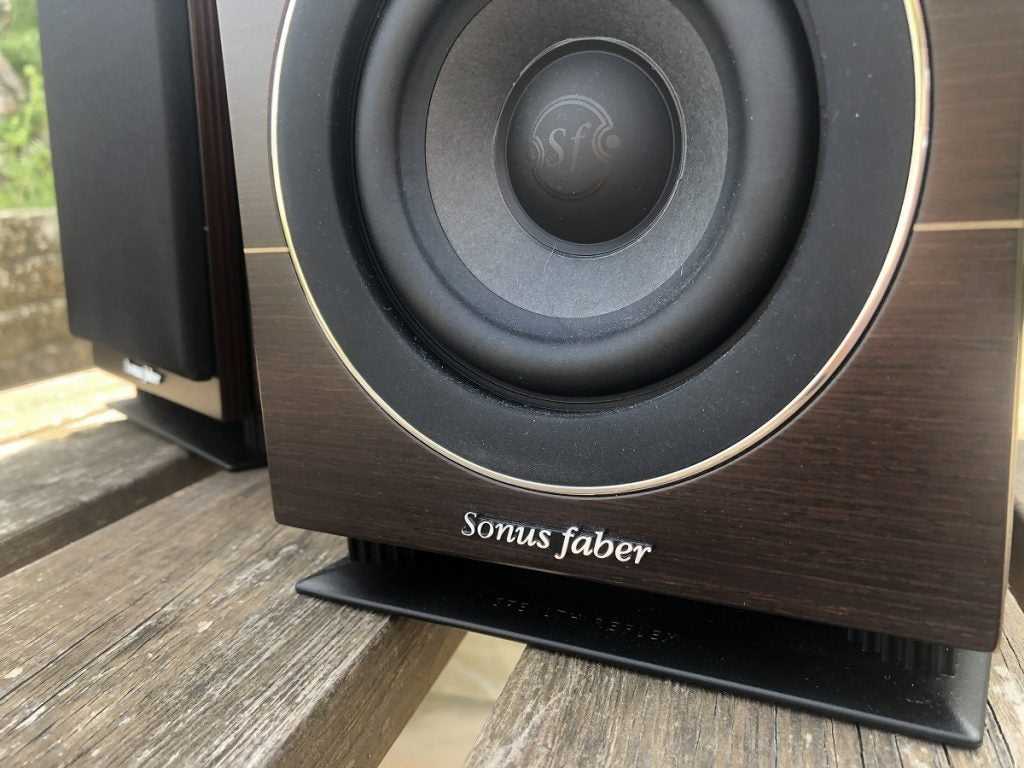
They seem happiest when dealing with recordings as compact and manageable as they are. Try These Days by Nico, for example – which has no real interest in rhythmic impetus – and the Lumina 1 are a genuinely enjoyable and engaging listen. Play to their strengths, then, and you’ll find them very agreeable companions.
Should you buy it?
You like your speakers to look a bit like a library The combination of wood veneer and real leather gives the Lumina 1 a rather olde-worlde look.
You’re after outright scale and punch Look at them – of course it’s going to be beyond them.
Final Thoughts
Play to their strengths (and don’t expect big-room scale) and the Sonus Faber hit far more than they miss.
Trusted Score
FAQs
How much does the Sonus Faber Lumina 1?
Each speaker weighs 4.4kg, so that’s a total of 8.8kg.
Can I bi-wire the Sonus Faber Lumina 1
Yes, the Lumina 1 does support bi-wiring if you’ve got the necessarily cables and amplifier that handle bi-wiring.
What amplifier should I partner the Lumina 1 with?
You’ll likely need an amplifier with a bit of power behind it to hear the Sonus Faber Lumina 1 at their best.
Specs
UK RRP
USA RRP
AUD RRP
Manufacturer
IP rating
Size (Dimensions)
Weight
ASIN
Release Date
Model Number
Driver (s)
Colours
Frequency Range
Sensitivity
Speaker Type
Sonus Faber Lumina 1
£799
$899
AU$1595
Sonus Faber
No
148 x 123 x 280 MM
4.4 KG
B08NR9R438
2013
Lumina 1
29mm high definition DAD tweeter, 120 mm paper cone mid-woofer
Black, Wedge, Walnut
65 24000 – Hz
84 dB
Hi-Fi Speaker
Знакомые черты
При разработке серии Lumina в компании не пошли на компромиссы ради себестоимости и наделили колонки основными техническими решениями, которые и составляют фирменное ноу-хау.
Прежде всего, это знакомый 29-мм купольный твитер из шелка с лаковой пропиткой и технологией DAD (Damped Apex Dome). Напомним, что купол в высшей точке задемпфирован металлической аркой — это позволяет устранить противофазные искажения, сохранив широкую дисперсию и звуковое давление на высоких частотах.
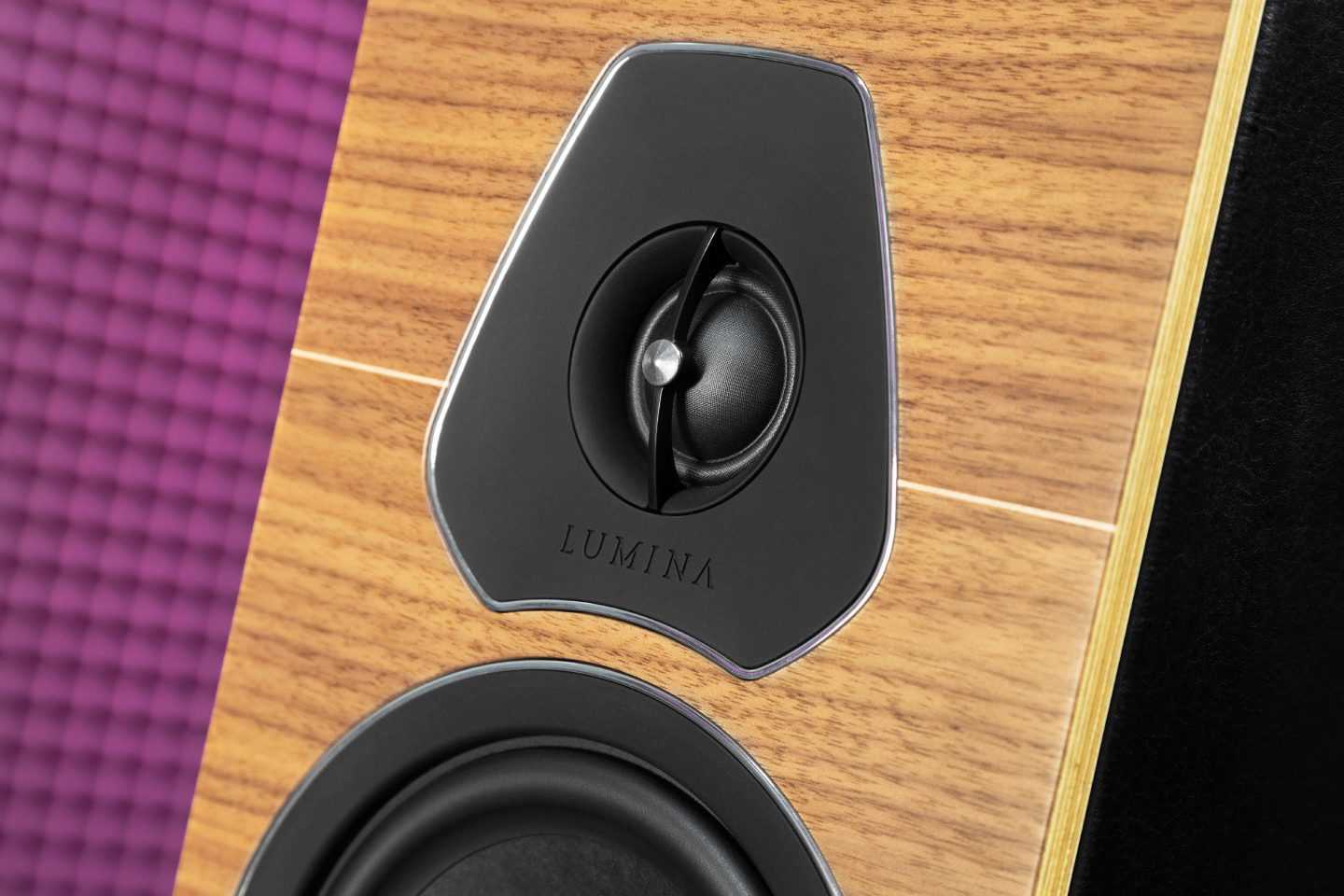 За натуральность воспроизведения высоких частот отвечает 29-мм купольный шелковый твитер с демпфирующей технологией DAD
За натуральность воспроизведения высоких частот отвечает 29-мм купольный шелковый твитер с демпфирующей технологией DAD
Как и у ряда старших моделей, средне- и низкочастотные динамики изготовлены по специальному заказу немецкой фирмой DKM. Отдельно разработанный для полочников 120-мм диффузор СЧ-излучателей, равно как и знакомые по серии Sonetto 150-мм среднечастотники, сделаны из нескольких видов целлюлозы и натуральных волокон, которые высушиваются естественным путем на открытом воздухе.
Специально для серии Lumina были разработаны и бумажные 150-мм НЧ-диффузоры, расположенные по две пары в напольных колонках. Как и во всех моделях компании, в новой серии применяются кроссоверы с патентованной схемой Paracross topology, которая помогает эффективно нивелировать фазовый сдвиг между динамиками.
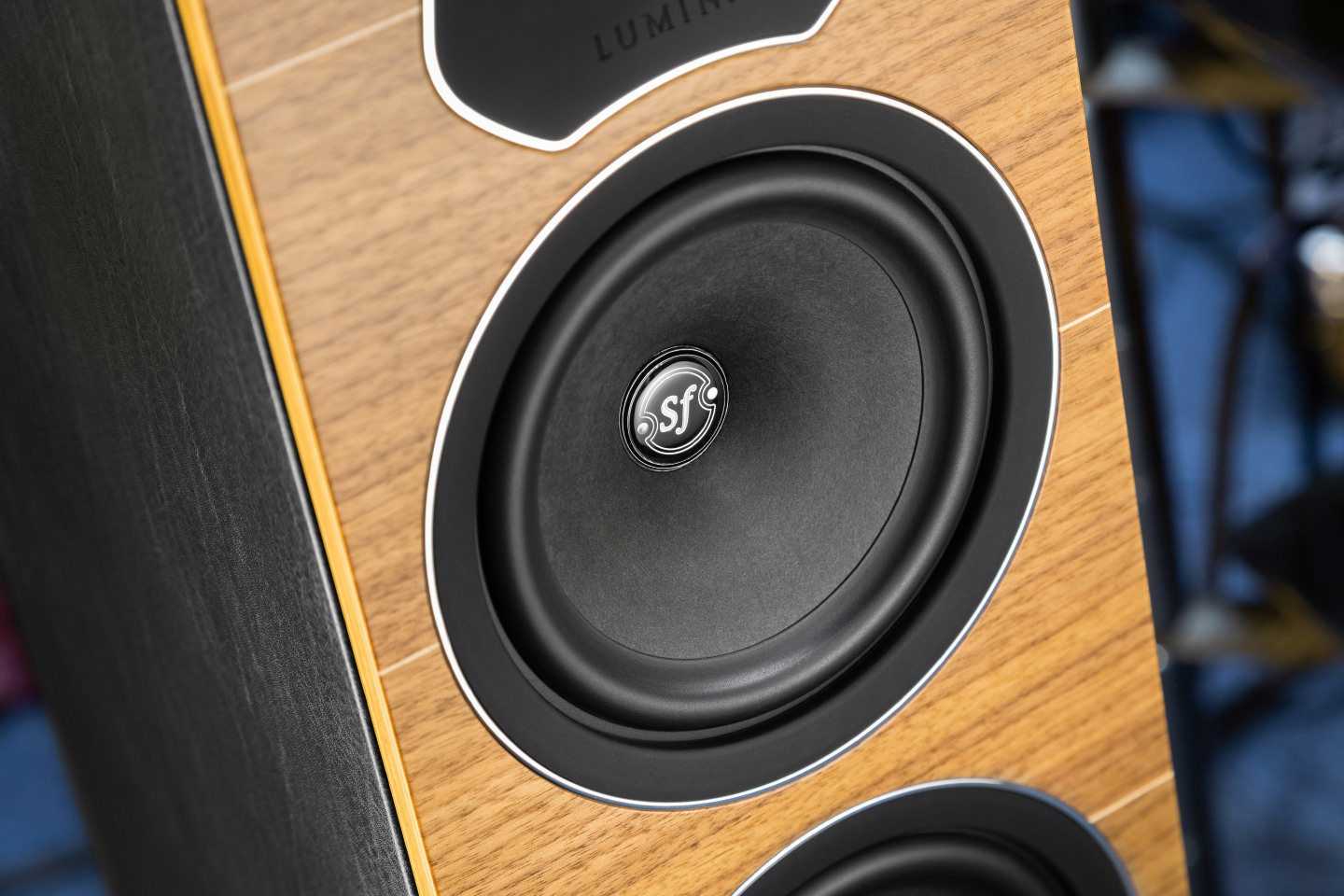 Среднечастотный 150-мм динамик с диффузором из разных типов целлюлозы знаком нам по серии Sonetto
Среднечастотный 150-мм динамик с диффузором из разных типов целлюлозы знаком нам по серии Sonetto
Фазоинвертор у напольников направлен в пол, а полочные колонки и центральный канал оснащены передними щелевыми портами, что делает их универсальными при размещении.
Стенки корпусов колонок изготовлены из MDF и обтянуты кожей. Фронтальная панель выполнена из жесткой фанеры (как утверждается, собранной из качественных натуральных сортов дерева), причем дизайнеры выставили это напоказ — мол, ничего личного, заданные характеристики корпуса превыше всего, но при этом лицевая часть отделана натуральным шпоном. Получилось, будто аристократ из парламента оделся чуть демократичнее для встречи с избирателями. Предлагаются три варианта отделки акустики: «орех», «венге» и черный рояльный лак.
Features
- Low sensitivity equals power-hungry
- 29mm tweeter and 120mm mid/bass driver
- Nickel-plated bi-wire terminals
Despite their manageable proportions, on an electrical level the Lumina 1 are a bit more of a handful. Sensitivity of 84dB and a nominal impedance of 4ohms means they’ll need to be powered by an amplifier with a bit of oomph if they’re to perform to their optimum.
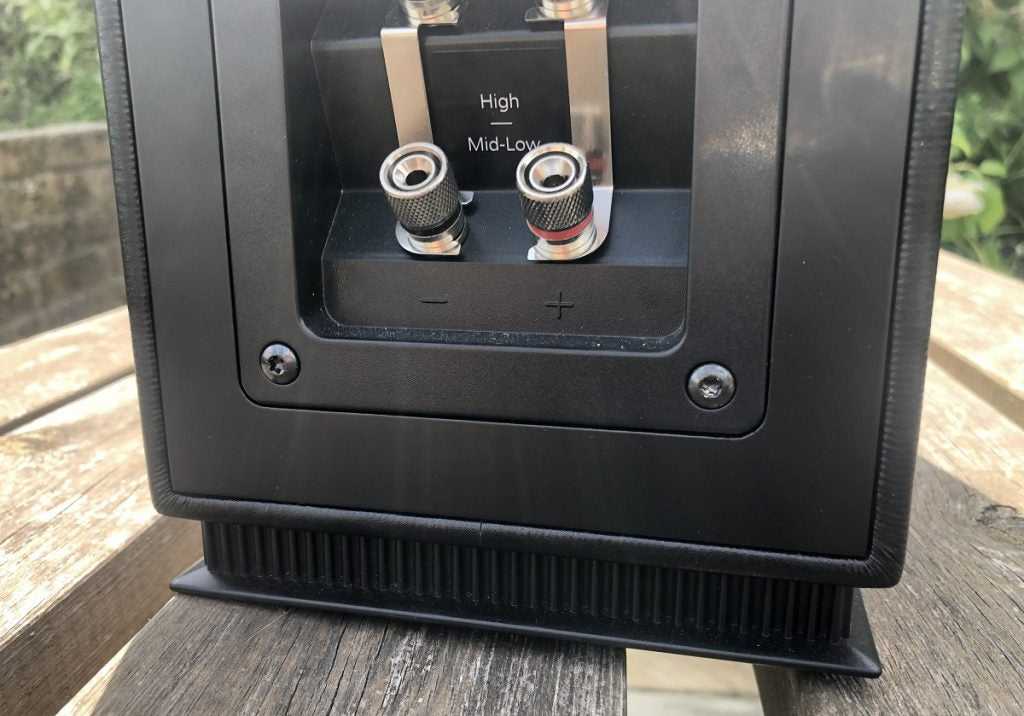
No matter the amplifier you deploy, it will be driving a big 29mm soft-dome tweeter and 120mm paper mid/bass cone in each speaker – and, if your amplifier (and your speaker cable budget) is up to it, they can each be driven independently thanks to the speakers’ bi-wire binding posts. Otherwise, crossover is at an unremarkable 2kHz.
Тяжелое испытание
Один мой знакомый делит всю аудиоаппаратуру на две категории: которая играет «Металлику» — или не играет. А у нас в комнате под рукой есть издание «Черного альбома» на четырех виниловых пластинках 45 об/мин от Warner Bros. Records. Вот и проверим.
Снова в деле Lumina III в паре с YBA Genesis IA3. «Enter Sandman» звучит жестко и хлестко. Низкие частоты собраны, можно сказать, «подсушены», зато они очень отчетливые — без намека на гул или размытость. Композиция «The Unforgiven» демонстрирует объем и энергию с акцентом на вокал, которые выступают как альтернатива тяжелым, бьющим в грудь басам.
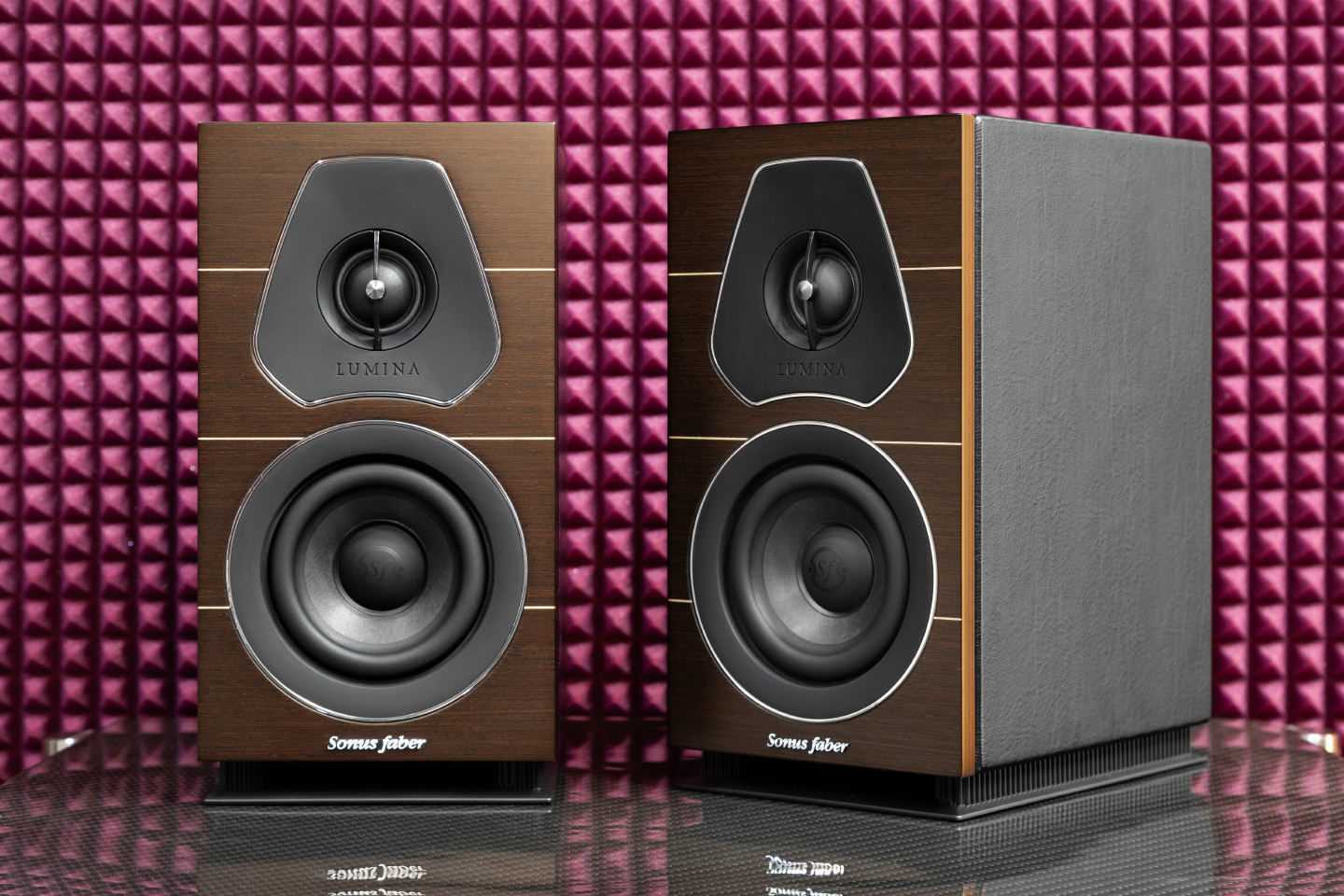 Полочники Lumina I для своих небольших размеров играют не просто громко и объемно, а создают масштабную трехмерную звуковую картину
Полочники Lumina I для своих небольших размеров играют не просто громко и объемно, а создают масштабную трехмерную звуковую картину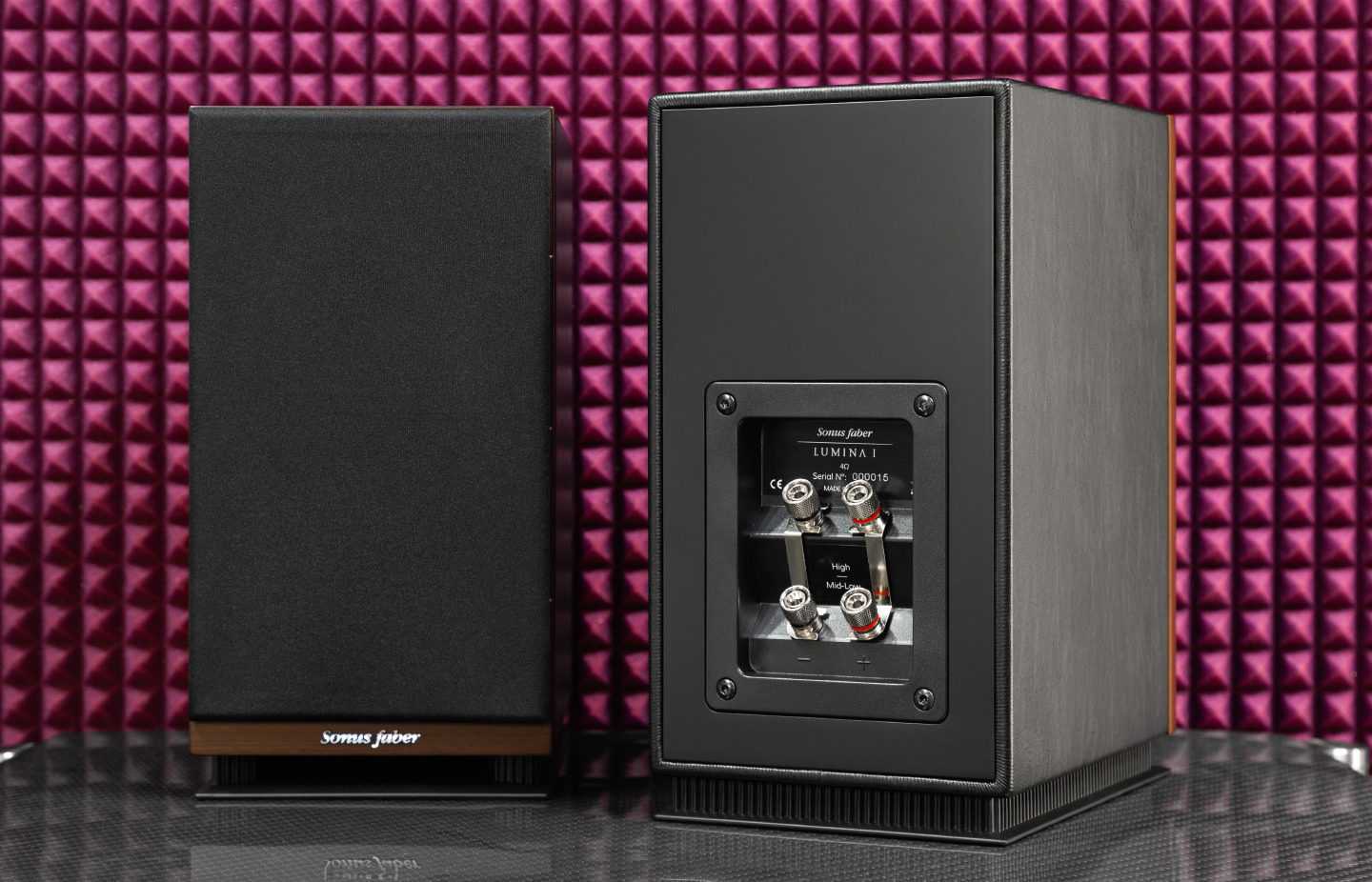
Полочники с тем же усилителем играют резче и злее — и такой энтузиазм вместе с высокой четкостью и собранностью тоже дает должный «металлический» эффект, пусть и без выраженных басов.
Если подключить напольники к McIntosh, то подача метала становится еще жестче и энергичнее. Я не басхэд — и меня такая интерпретация более чем устраивает. В любом случае, при должном усилении тяжелыми жанрами серию Lumina не напугать.
А если поставить винил с мелодичным роком — например, эталонным для такого случая «Brothers in Arms» Dire Straits, — то снова наблюдается эффект растворения колонок в музыке, будь то напольники или полочники. Конечно, в силу конструкции и акустических параметров первые играют объемнее, насыщеннее и информативнее.
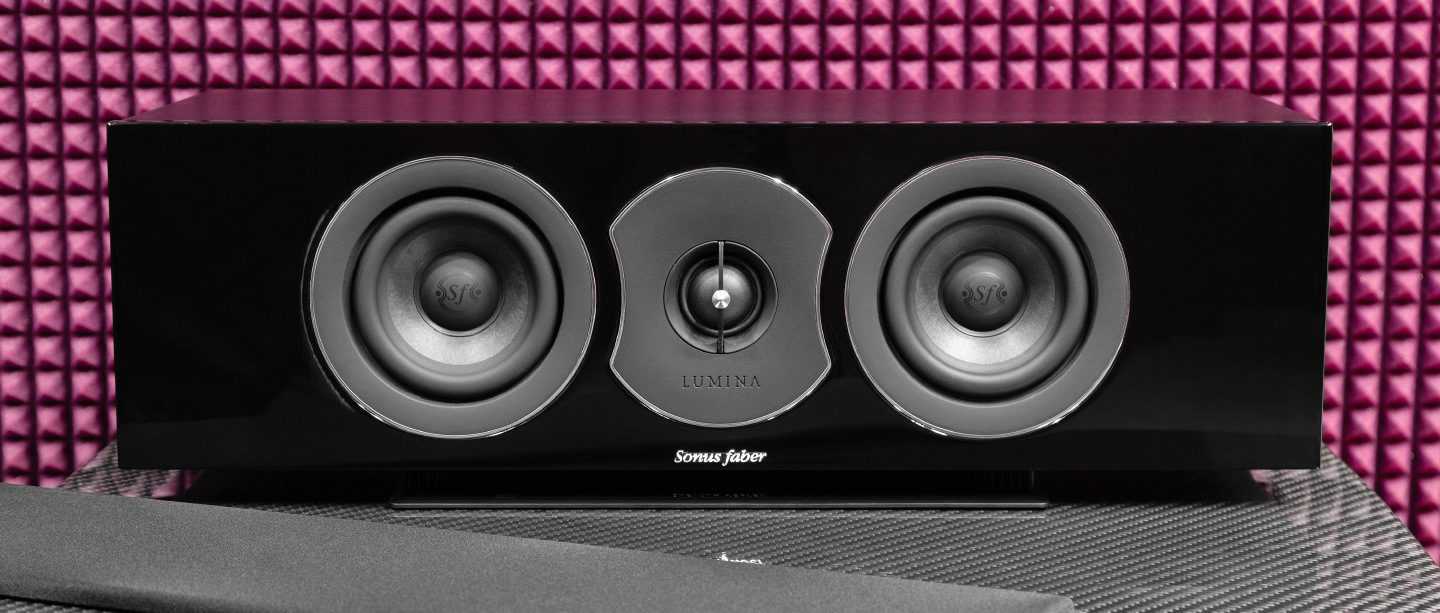 Колонка центрального канала Lumina Center I рассчитана на применение в системе домашнего кинотеатра
Колонка центрального канала Lumina Center I рассчитана на применение в системе домашнего кинотеатра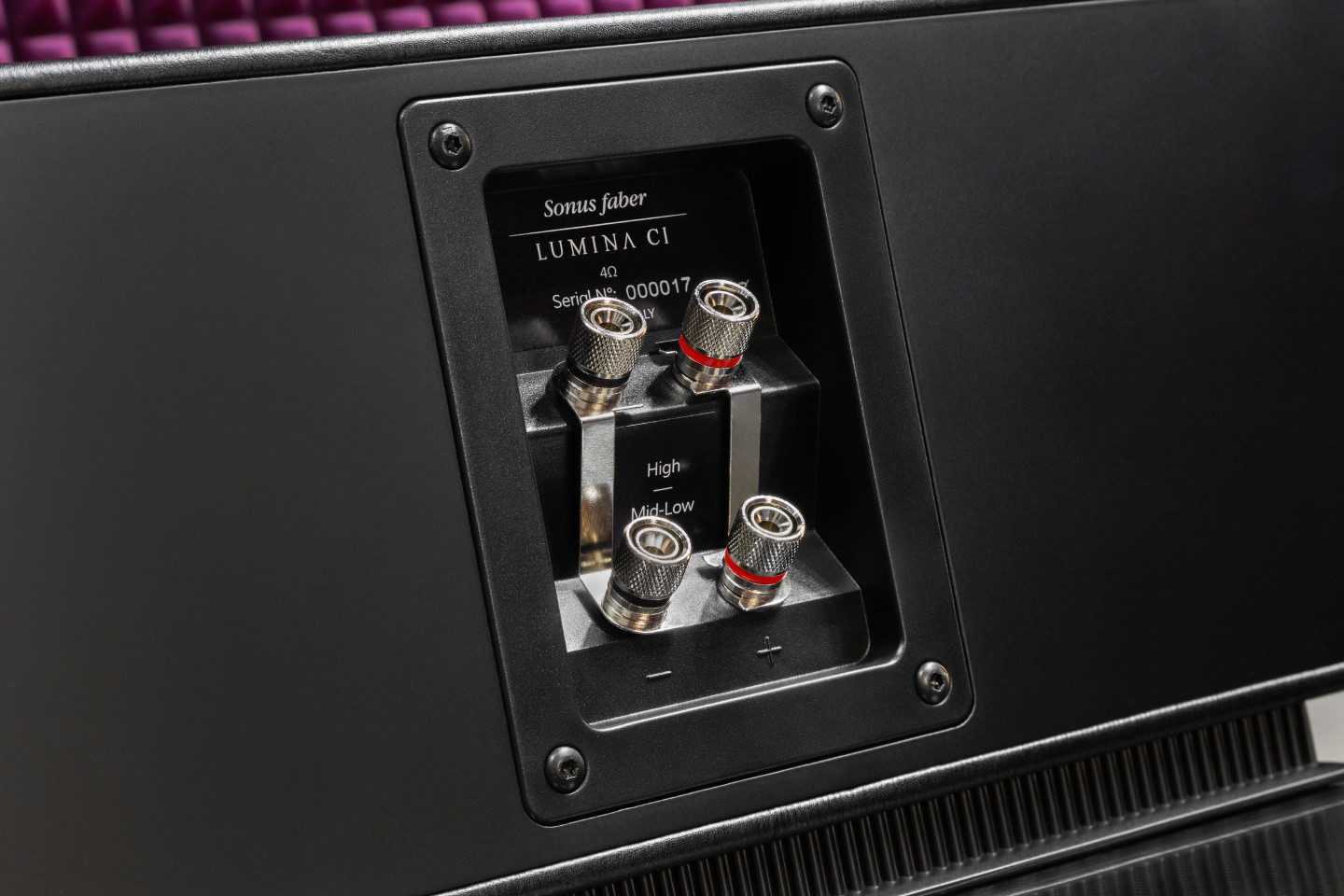
И здесь я начинаю понимать ведущего разработчика Sonus faber Паоло Тецциона, который ощущает себя, скорее, меломаном, нежели аудиофилом и предпочитает, чтобы люди сосредоточились на музыке, а не аппаратуре. Перед нами как раз тот случай, когда нет желания алгеброй проверять гармонию — делать измерения, сопоставлять графики АЧХ, улавливать «горбики» и спады (хотя с этим все в порядке). А хочется здесь и сейчас слушать музыку такой, какая она есть — просто получая удовольствие.
Sound quality
Connected to a Cambridge Audio Edge A, which comfortably exceeds this figure, the Lumina III makes good on the promise of being fundamentally easy to position. While it does its best work a little way from boundary walls, it is otherwise very consistent in its behaviour almost regardless of how it is sited. I settle on roughly 3m apart, gently toed-in toward the listening position.
The Lumina III manages to balance some of the expected virtues of the Sonus faber house sound with some new tricks. The use of the dedicated midrange driver pays dividends. Operating between 350Hz and 3.5kHz, it gives an impressive emphasis to vocals and critical instruments. Nicolas Michaux’s Amour Colere is reproduced with his soulful vocal turn becoming the centre of attention with the supporting instrumentation arranged as a convincing layer behind. This proceeds upward to the tweeter that balances fine detail retrieval with impressive refinement. The handover between the drivers is encouragingly seamless too. The decision to use a very similar driver for midrange and bass work undoubtedly helps.
There is also a seductive quality to how it presents material that makes it extremely easy to listen to. It isn’t warm, but there is a smoothness and tonal richness that helps it to deliver music in a way that is something you can enjoy for extended periods without fatigue. The bombast of The Comet Is Coming’s Trust In The Lifeforce Of The Deep Mystery is fuller and less jarring than it can be on other speakers, but the clever part of this balance is that the fury and frenetic energy of the performance is retained while it does so.
However, not everything is quite so accomplished. For a speaker standing nearly a metre tall and possessed of a pair of bass drivers, the Lumina III’s low end never feels hugely potent. As with all aspects of speaker design and voicing, it feels like Sonus faber has favoured the integration between drivers over outright punch. If you absolutely must have the punch-in-your-sternum-style impact that some designs can offer, this probably isn’t the speaker for you. This also has a slight but perceptible effect on the sense of scale that is delivered.
There is a twist to this, though, that is slightly unexpected. Whatever trade-offs have been made in terms of bass weight result in good speed and dynamics. The idea that Sonus faber speakers are languid and optimised purely for gentle activities has always been a little overblown, but the Lumina III has a speed and attack to its presentation that is bit of a surprise. The way it deals with Mark Lanegan’s crunching The Gravedigger’s Song is hugely and unapologetically entertaining. There’s just enough civility to ensure it doesn’t overstay its welcome, but it is far more visceral than you might reasonably expect.
No less impressive is that the forgiving edge doesn’t rob the Lumina III of the ability to shine with better recordings. Poppy Ackroyd’s stunning Resolve – as effortless a blurring of the margins of modern classic and electronica as I’ve yet to hear -is masterfully reproduced. The fascinating details of Ackroyd’s work (when she ‘plays’ a piano, she doesn’t merely use the keys) are stitched into the wider performance in a way that illuminates its presence without it becoming a distraction. The presentation fizzles with an energy that compels you to keep listening.
Sound
(Image credit: Sonus Faber)
Once up and running, these little boxes are surprisingly confident performers. Their presentation is bolder and more full-bodied than their size suggests. Even so, don’t expect miracles, as something this small will never be able to deliver seismic lows or convey large-scale dynamics with a full dose of authority. Larger, cheaper speakers, such as Bowers & Wilkins’ 606 S2, are clearly superior in those respects.
Sonus Faber Lumina 1 tech specs
(Image credit: Sonus Faber)
Type 2-way bookshelf loudspeaker
Crossover frequency 2kHz
Frequency response 65Hz to 24kHz
Sensitivity 84dB
Impedance 4 ohms
Dimensions (hwd) 28 x 15 x 21cm
Weight 4.4kg (each)
But that doesn’t stop the Lumina 1 from having plenty of appeal. Those drive units are beautifully integrated. We listen to Laurie Anderson’s Homeland set, and the speakers do a great job with her distinctive voice. There’s plenty of detail, nuance and natural warmth here, as well as a pleasing degree of solidity. These standmounters focus on the humanness of Anderson’s performance rather than just tick the boxes regarding the technicalities of sound reproduction.
My Right Eye demonstrates the Lumina 1’s surprising ability at low frequencies. While certainly limited in terms of depth, these speakers sound impressively punchy with the bass they do produce. Low-end notes are taut, articulate and fuller than we would have expected.
At the other end of the frequency spectrum, we like the way the Lumina 1 deal with treble. The high frequencies are sweet and refined but have enough in the way of bite when to music demands. While this isn’t the most open-sounding of tweeters, its character blends well with that of the mid/bass.
Things could be better rhythmically, though. The Lumina prefer a more relaxed approach to musical replay and don’t render the drive or momentum in the music with any great determination. They still manage to entertain, but that’s because of their midrange finesse and easy-going nature.
Smaller scale classical or jazz pieces work well with them – rhythmical precision aside, that is. Listen to Kind Of Blue by Miles Davis or Found Songs by Ólafur Arnalds and the standmounters sounds right at home. Their smooth tonal balance, credible detail levels and innate sense of calm works well with music such as this. We like their lack of overt aggression; it makes for a relaxing musical experience.
Of course, playing something larger scale such as Beethoven’s Fifth Symphony shows up limitations compared to larger rivals. But there’s still plenty in the way of insight and dynamic interplay to keep us entertained.
Design
- Usefully compact
- Premium materials
- Choice of finishes
As long as you’re not expecting any radical departure from the norm, the Sonus Faber Lumina 1 are quite a nicely designed and undeniably well-finished loudspeaker.
The tidily finished front panel is available in a choice of real-wood veneers – take your pick from wenge or walnut. Or, there’s a shiny black alternative available, too. However, no matter which you select, it will feature some shiny chromed accents around each driver housing – which, to me at least, is reminiscent of nothing more than the back-end of an old Rover 600. Wrapping the top and side of the cabinet in leather does nothing to diminish the ‘old-school Rover’ vibe, either.
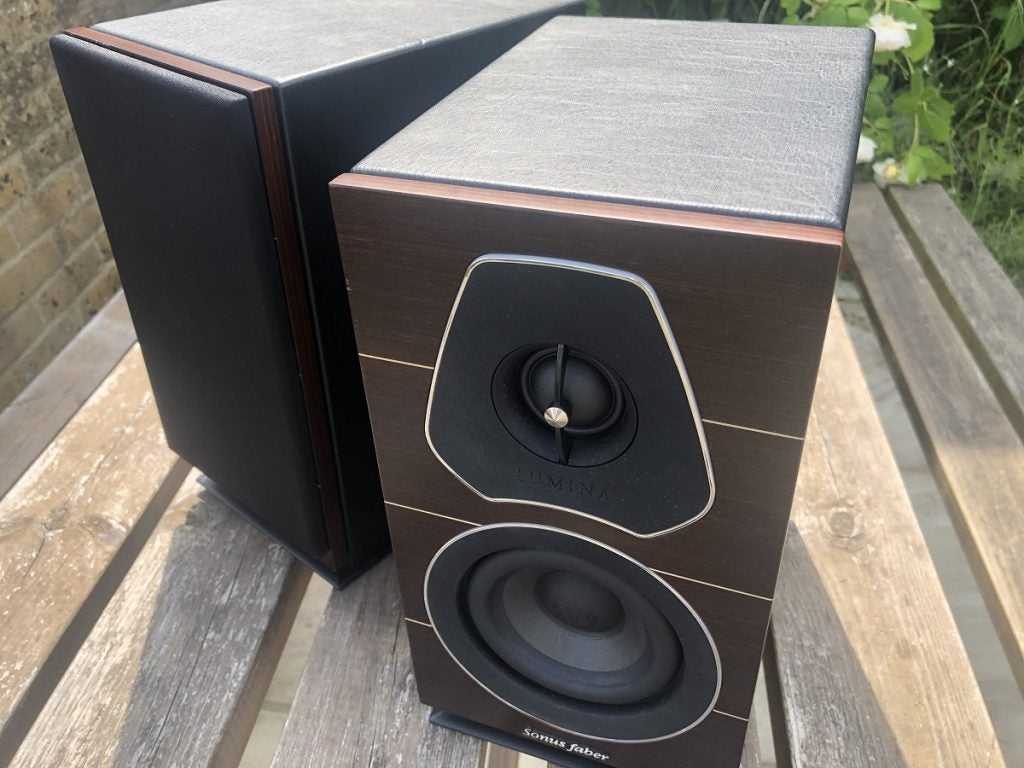
Of course, one man’s ‘rather chintzy’ is another’s ‘luxuriously sophisticated’, so it’s worth seeing the Lumina 1 ‘in the flesh’ before you make up your mind. What isn’t up for debate, though, is the quality of these materials or the way they’re deployed. Or their tactility, for that matter.
The dimensions make the Lumina 1 a great option for smaller listening rooms, and the forward-firing bass reflex port makes them even more flexible in terms of positioning. The Sonus Faber stand on little plastic plinths (which look and feel a fair bit more prosaic than the rest of the cabinet), the front of which are vented to allow the port to do its thing.
«NA» — НАТУРАЛЬНОЕ ЗВУЧАНИЕ
Наконец, последние две буквы олицетворяют естественное воспроизведение звука и Голоса Sonus faber. Электроакустическая конструкция колонок Lumina нацелена на решения, созданные для современного образа жизни и различных мест прослушивания, без ущерба для качества воспроизведения. Многоканальные системы и мультимедийные решения идеально подходят для акустических систем Lumina, предлагая отличное звучание в помещении, где слушатель может насладиться захватывающим и аутентичным ощущением в любом месте комнаты. Благодаря обновленным технологиям колонки Lumina невероятно легко размещаются и отлично звучат, где бы они ни находились — даже рядом с задней стеной или на книжной полке. Прелесть новой коллекции Lumina заключается в том, что их можно разместить практически в любом месте, и при этом они будут обладать потрясающим качеством звука.
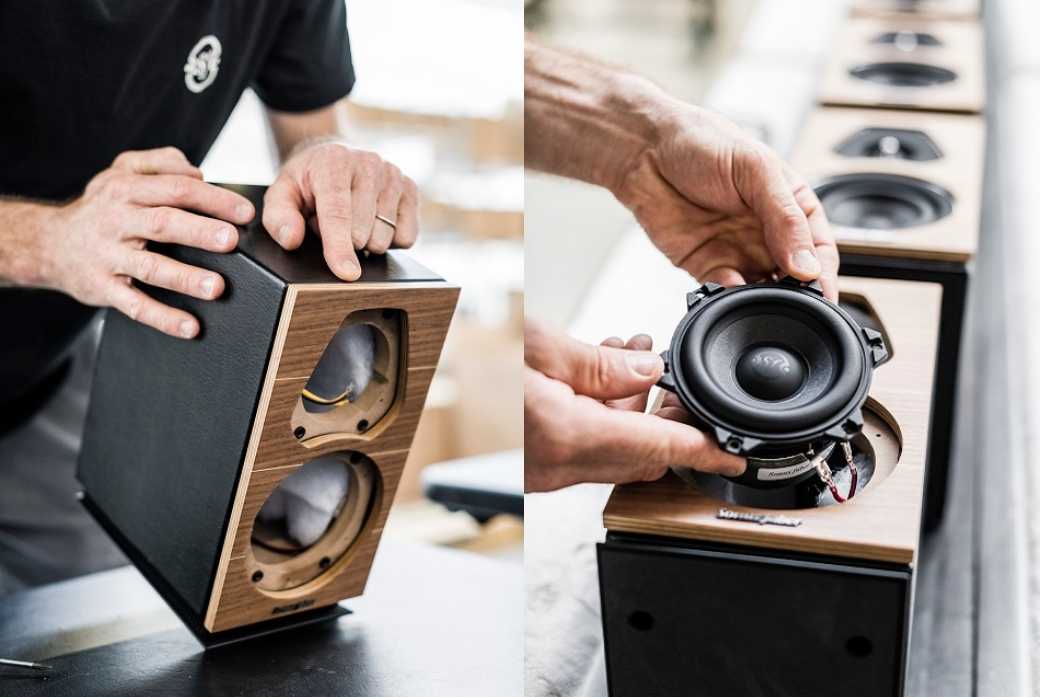
С точки зрения динамиков, колонки Lumina используют следующие решения:
- Знаменитый D.A.D. (Damped Apex Dome TM) высокочастотный динамик, тот же, что используется в серии Sonetto, с 29-миллиметровой диафрагмой от Kurtmueller из мягкого шелка, изготовленный вручную;
- Совершенно новый 4-дюймовый СЧ/НЧ-динамик, недавно разработанный для этой коллекции и оснащенный изготовленной на заказ корзиной и диафрагмой на основе целлюлозной массы, смешанной с другими натуральными волокнами;
- 5-дюймовые среднечастотные динамики пришли от старших сестер серии колонок Sonetto и по-прежнему имеют нашу запатентованную диафрагму из смеси натуральных волокон и бумаги, высушенную на воздухе;
- 5-дюймовые низкочастотные динамики были разработаны с нуля для этой цели и также имеют диффузор из бумажной массы для идеальной звуковой согласованности с остальными драйверами.
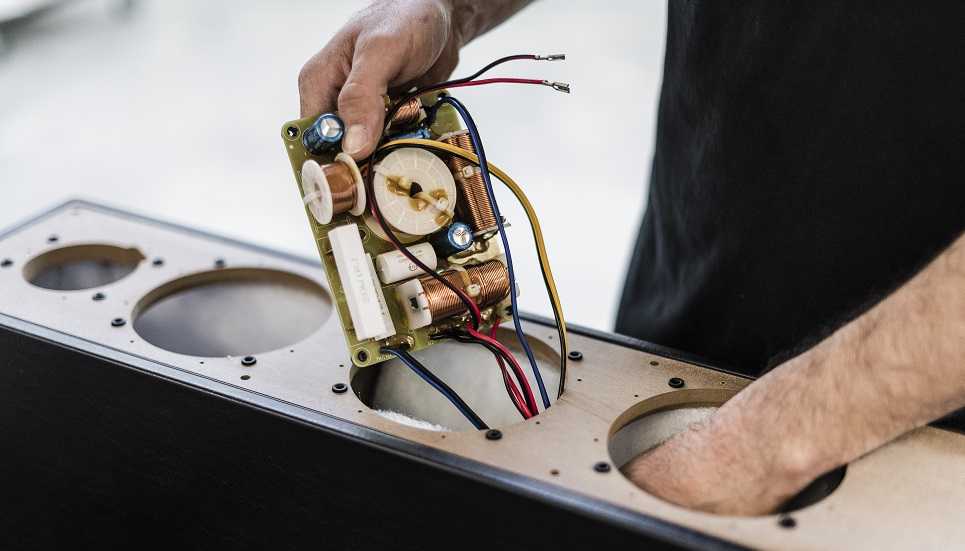
Порты фазоинверторов придают дополнительную универсальность всему модельному ряду и размещены на лицевой стороне полочных колонок, а также колонке центрального канала и порты, направленные вниз у напольных колонок. Благодаря такому решению колонки Lumina значительно менее чувствительны к размещению, обеспечивая высокое качество звука даже при в непосредственной близости с задней стеной или при установке на книжную полку. Красота акустических систем Lumina заключается в том, что вы можете разместить их где хотите и сможете насладиться великолепным дизайном данных АС.
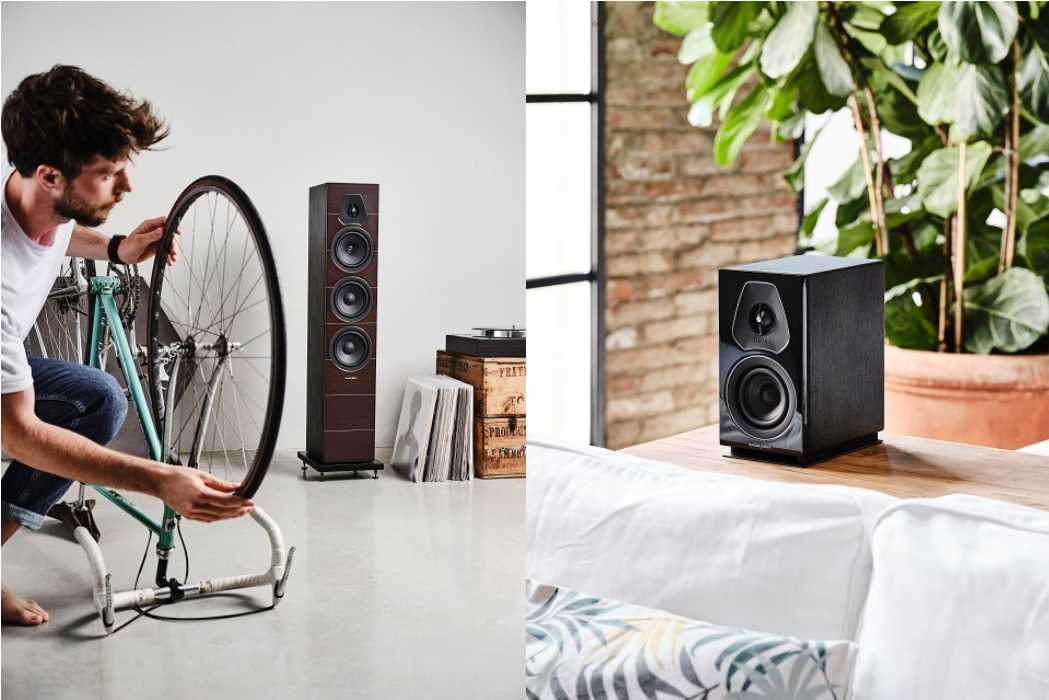
Build
(Image credit: Sonus Faber)
The Lumina 1’s boxes are tiny – about the size of a shoebox – but that hasn’t stopped Sonus Faber from making them look special for the money. The plywood front panel is lovely with its real wood veneer (available in either walnut or wenge) and maple inlays.
The chrome detailing around the drive units could be considered a little glitzy, but we are certainly fans of the real leather wrap around the sides and top of the MDF cabinet. The back panel is simply painted black, and that’s fine with us.
We’re less happy with the moulded plastic base, though. While it is relatively sturdy and serves a useful purpose by forming the front-firing reflex port, it also feels a little cheap. Still, overall there is little else to complain about here, with the Lumina 1 looking and feeling far more luxurious than most alternatives at this price.
These speakers are a two-way design with a small 12cm paper cone mid/bass unit coupled to a larger-than-average (29mm) silk dome tweeter. It’s the same high-frequency unit used in the company’s more premium Sonetto range, and in this installation covers frequencies over 2kHz.
«MI» – МИНИМАЛИСТИЧНЫЙ ДИЗАЙН
Две вторые буквы отражают минимализм. Принцип минимализма напрямую отражает суть новых колонок, которые были тщательно сконструированы и изготовлены в сочетании с идеей «лучше меньше да лучше». Новая коллекция сочетает в себе фундаментальные ценности Sonus faber и лучшие материалы, которые олицетворяют бренд, такие, как натуральная многослойная древесина и кожа. Всё это объединяет их с невероятным качеством воспроизведения и кажущемся на первый взгляд простым, но тем не менее потрясающем дизайне. Простота остается центральным элементом индивидуальности коллекции благодаря лёгкости установки, доступной цене и отличным звуковым характеристикам — предоставляя возможность насладиться истинным звучанием Sonus faber каждому человеку.
Корпус колонок , которые входят в коллекцию имеет идеальную прямоугольную форму — дизайнерский отдел Sonus faber выполнил этот минималистичный дизайн, чтобы подчеркнуть качество используемых материалов. Пропорции корпуса были проработаны самым доскональным образом, чтобы гарантировать точные объемы для воспроизведения звука и компактность для удобства установки.
Многослойное дерево и натуральный шпон передней панели колонки Lumina доступны в отделки знаковых колонках премиум класса, и включают орех и венге, оба в матовом исполнении со вставками из клена, а также третий вариант с отделкой в черном рояльном лаке. Все остальные поверхности колонки вручную обтянуты нашей легендарной черной кожей. Хромированные кольца вокруг динамиков подчеркивают формы и пропорции и придают яркость передней панели, подчеркивая характер звучания Sonus faber. Колонки Lumina также снабжены двумя парами никелированных клемм, что позволяет усовершенствовать систему с помощью двухпроводного подключения или двухканального усиления. Кроссоверы в Lumina используют специально разработанные высококачественные конденсаторы изготовленные под маркой Sonus Faber.
